Experimental Study on the Process of Submerged Arc Welding for Nickel-Based WC Flux-Cored Wire on Descaling Roll
Abstract
1. Introduction
2. Experiment on Submerged Arc Surfacing with Flux-Cored Wire
2.1. The Materials of Submerged Arc Surfacing Welding Experimental
2.2. Submerged Arc Surfacing Experiment of Flux-Cored Wire
3. Experimental Characterization for Surfacing Layer Materials
3.1. Experiments with SEM and EDS
3.2. XRD Experimental Scheme
3.3. Microhardness Experiment
3.4. Friction and Wear Experiment
3.5. Electrochemical Corrosion Experiment
3.6. Impact Energy Experiment
4. Analysis of Experiment Results
4.1. Analysis of SEM and EDS Experiment Results
4.1.1. The Results of 70% NiCrBSi + 30% WC Filler Metal without the Bottom Layer Welding
4.1.2. 70% NiCrBSi + 30% WC Filler Metal with the Bottom Layer
4.1.3. 40% NiCrBSi + 60% WC Filler Metal with the Bottom Layer
4.2. Analysis of XRD Experiment Results
4.3. Analysis of Microhardness
4.4. Analysis of Friction and Wear Results
4.5. Analysis of Electrochemical Corrosion Experiment Results
4.6. Analysis of Impact Power Experiment Results
4.6.1. 70% NiCrBSi + 30% WC Filler Metal without the Bottom Layer
4.6.2. 70% NiCrBSi + 30% WC Filler Metal with the Bottom Layer
5. Conclusions
- (1)
- SEM and EDS experiments show that the WC hard phase is dissolved after submerged arc welding, and the hard phase with mesh structure is formed and distributed in the whole welding layer. Under different WC content, the hard phase density generated at the same position of the welding layer is different, and the hard phase element content is different to some extent. The hard phase deposits are mainly composed of fishbone, neuronal, flower-like and flower-flocculent structures, and the binding phase is mainly an Ni–Fe solid solution. An Fe–Ni block is formed at the fusion zone of the welding layer and the substrate, which is attached to the fusion line.
- (2)
- The submerged arc welding layer XRD analysis shows that the hard phase is mainly composed of CrFe8Si, Fe3Si, Ni3C, and C-Cr, and the bonding phase is mainly an Fe–Ni solid solution. 70% NiCrBSi + 30% WC filler metal has the highest peak of the bottom layer, and the generated hard phase is the most, resulting in the highest hardness of the welding layer, and the highest hardness of the hard phase is close to 1000 HV.
- (3)
- Because 40% NiCrBSi + 60% WC filler metal with the bottom layer has more WC content, the generated hard phase network structure is sparse, resulting in lower hardness than the former, and the maximum hardness is 673 HV. The hardness of the welding layer is more than 2.5 times that of the substrate. The abrasion resistance of 70% NiCrBSi + 30% WC welding layer is better than that of 40% NiCrBSi + 60% WC welding layer, the friction coefficient of the former is 0.2136, and the friction coefficient of the latter is 0.2732.
- (4)
- The polarization curve of the electrochemical corrosion experiment shows that the corrosion resistance of 40% NiCrBSi + 60% WC welding layer is better than that of 70% NiCrBSi + 30% WC welding layer. The corrosion potential of the welding layer is more negative than that of 304 stainless steel, and the self-corrosion current density of the welding layer is two orders of magnitude higher than that of 304 stainless steel, and the corrosion rate is higher.
- (5)
- The average impact toughness of 70% NiCrBSi + 30% WC filler metal without the bottom layer is 36.57 J/cm2, and the average total impact energy is 13.19 J. The average impact toughness of 70% NiCrBSi + 30% WC filler metal with the bottom layer is 6.65 J/cm2, and the average total impact energy is 13.19 J. The impact surface of the substrate is bone-shaped, the impact surface of the welding layer is flake-shaped, and spherical Fe-Ni is scattered in the area of the welding layer.
Author Contributions
Funding
Institutional Review Board Statement
Informed Consent Statement
Data Availability Statement
Conflicts of Interest
References
- Choudhary, A.; Kumar, M.; Gupta, M.K.; Unune, D.K.; Mia, M. Mathematical modeling and intelligent optimization of submerged arc welding process parameters using hybrid PSO-GA evolutionary algorithms. Neural Comput. Appl. 2019, 32, 5761–5774. [Google Scholar] [CrossRef]
- Rebelo Kornmeier, J.; Marques, M.J.; Gan, W.; Batista, A.C.; Paddea, S.; Loureiro, A. Quantification of Residual Stress Relief by Heat Treatments in Austenitic Cladded Layers. Materials 2022, 15, 1364. [Google Scholar] [CrossRef] [PubMed]
- Kumar Choudhary, M.; Unune, D.R. Experimental investigation and optimization of weld bead characteristics during submerged arc welding of AISI 1023 steel. Def. Technol. 2019, 15, 72–82. [Google Scholar] [CrossRef]
- Shi, X.-L.; Xiu, S.-C.; Su, H.-L. Residual stress model of pre-stressed dry grinding considering coupling of thermal, stress, and phase transformation. Adv. Manuf. 2019, 7, 401–410. [Google Scholar] [CrossRef]
- Zhang, J.; Shao, G.; Fan, J.; Wang, L.; Zhang, D. A Review on Parallel Development of Flux Design and Thermodynamics Subject to Submerged Arc Welding. Processes 2022, 10, 2305. [Google Scholar] [CrossRef]
- Mahapatra, M.M.; Datta, G.L.; Pradhan, B.; Mandal, N.R. Three-dimensional finite element analysis to predict the effects of SAW process parameters on temperature distribution and angular distortions in single-pass butt joints with top and bottom reinforcements. Int. J. Press. Vessel. Pip. 2006, 83, 721–729. [Google Scholar] [CrossRef]
- Cheng, R.; Zhang, J.; Wang, B. Closure behavior of spherical void in slab during hot rolling process. Metall. Res. Technol. 2018, 115, 301. [Google Scholar] [CrossRef]
- Viňáš, J.; Brezinová, J.; Guzanová, A.; Svetlík, J. Degradation of renovation layers deposited on continuous steel casting rollers by submerged arc welding. Proc. Inst. Mech. Eng. Part B J. Eng. Manuf. 2013, 227, 1841–1848. [Google Scholar] [CrossRef]
- Sharma, L.; Chhibber, R. Experimental investigation of structural integrity behavior of High strength low alloy steel—Study of mechanical, microstructural and corrosion behavior of Submerged arc welding weldments. Proc. Inst. Mech. Eng. Part E J. Process Mech. Eng. 2020, 235, 266–273. [Google Scholar] [CrossRef]
- Saini, S.; Singh, K. Recycling of steel slag as a flux for submerged arc welding and its effects on chemistry and performance of welds. Int. J. Adv. Manuf. Technol. 2021, 114, 1165–1177. [Google Scholar] [CrossRef]
- Chen, Z.; Peng, K.; Chen, X.; Wang, Q.; Liang, Y. Comparative Investigation of Multi-stranded Wire and Single Wire in Submerged Arc Welded Joints of Duplex Stainless Steel: Microstructure and Pitting Properties. J. Mater. Eng. Perform. 2023, 1–11. [Google Scholar] [CrossRef]
- Zhang, H.F.; Zhang, C.H.; Wang, Z.Y.; Cui, X.; Zhang, S.; Chen, H.T. Microstructure and corrosion behaviour of WC/NiCrBSi coatings by vacuum cladding. Mater. Sci. Technol. 2022, 38, 19–29. [Google Scholar] [CrossRef]
- Deenadayalan, K.; Murali, V. Role of various weight percentages of WC particle on interface thickness and friction-wear property of NiCrBSi-WC composite fabricated using PTAW process. Mater. Res. Express 2019, 6, 046542. [Google Scholar] [CrossRef]
- Deenadayalan, K.; Murali, V.; Elayaperumal, A.; Arulvel, S. Effective role of short time furnace heat treatment and laser treatment on the residual stress and mechanical properties of NiCrBSi–WC weldments produced using plasma transferred arc welding process. J. Mater. Res. Technol. 2021, 15, 3492–3513. [Google Scholar] [CrossRef]
- Wang, Y.Y.; Gong, Y.F.; Sun, T.F.; Ni, P.F.; Liu, Z.; Gao, G.H.; Li, C.J. Effect of Powder Size and Volume Fraction of WC on the Microstructure of Laser Cladding WC-NiCrBSi Composite Coatings. Appl. Mech. Mater. 2011, 121–126, 105–109. [Google Scholar] [CrossRef]
- Han, F.; Zhang, X.D.; Sun, Y.F. Microstructure and Properties of NiFeCrBSi/WC Composite Coatings Fabricated by Vacuum Cladding. Phys. Met. Metallogr. 2019, 120, 898–906. [Google Scholar] [CrossRef]
- Cherepanov, A.N.; Orishich, A.M.; Ovcharenko, V.E.; Malikov, A.G.; Drozdov, V.O.; Pshenichnikov, A.P. Influence of Modifying Nanoadditives on the Properties of a Multilayer Composite Coating Obtained by Laser Welding. Phys. Met. Metallogr. 2019, 120, 101–106. [Google Scholar] [CrossRef]
- Wang, J.; Zhou, J.; Zhang, T.; Meng, X.; Li, P.; Huang, S.; Zhu, H. Ultrasonic-Induced Grain Refinement in Laser Cladding Nickel-Based Superalloy Reinforced by WC Particles. Coatings 2023, 13, 151. [Google Scholar] [CrossRef]
- Chmielewski, T.; Golański, D. The role of welding in the remanufacturing process. Weld. Int. 2015, 29, 861–864. [Google Scholar] [CrossRef]
- Luzan, S.A.; Sidashenko, A.I.; Luzan, A.S. The wear resistance increasing of the deposited coatings of the Ni-Cr-B-Si system by modifying them with composite materials synthesized using the SHS process (Self-propagating high-temperature synthesis). Weld. Int. 2021, 33, 249–254. [Google Scholar] [CrossRef]
- Mortazavian, E.; Wang, Z.; Teng, H. Repair of light rail track through restoration of the worn part of the railhead using submerged arc welding process. Int. J. Adv. Manuf. Technol. 2020, 107, 3315–3332. [Google Scholar] [CrossRef]
- Kik, T.; Moravec, J.; Svec, M. Experiments and Numerical Simulations of the Annealing Temperature Influence on the Residual Stresses Level in S700MC Steel Welded Elements. Materials 2020, 13, 5289. [Google Scholar] [CrossRef] [PubMed]
- He, Q.; Wei, H.; Chen, J.S.; Wang, H.P.; Carlson, B.E. Analysis of hot cracking during lap joint laser welding processes using the melting state-based thermomechanical modeling approach. Int. J. Adv. Manuf. Technol. 2017, 94, 4373–4386. [Google Scholar] [CrossRef]
- Yu, S.; Lu, W.; Zhang, Y.; Xie, M.; Wang, C. Development of HYDCrMo Hardfacing Flux Cored Wire for Submerged Arc Welding. Mater. Mech. Eng. 2003, 27, 35–37. [Google Scholar]
- GB/T229-2020; Metallic Materials Charpy Pendulum Impact Test-Part l: Test Method. State Administration for Market Regulation and Standardization Administration: Beijing, China, 2020.
- Ciubotariu, C.R.; Frunzaverde, D.; Marginean, G. Investigations of Cavitation Erosion and Corrosion Behavior of Flame-Sprayed NiCrBSi/WC-12Co Composite Coatings. Materials 2022, 15, 2943. [Google Scholar] [CrossRef] [PubMed]
- Xiao, J.K.; Wu, Y.Q.; Zhang, W.; Chen, J.; Wei, X.L.; Zhang, C. Microstructure, wear and corrosion behaviors of plasma sprayed NiCrBSi-Zr coating. Surf. Coat. Technol. 2019, 360, 172–180. [Google Scholar] [CrossRef]
- Sabzi, M.; Dezfuli, S.M.; Mirsaeedghazi, S.M. The effect of pulse-reverse electroplating bath temperature on the wear/corrosion response of Ni-Co/tungsten carbide nanocomposite coating during layer deposition. Ceram. Int. 2018, 44, 19492–19504. [Google Scholar] [CrossRef]
- Zeng, Q.; Sun, J.; Emori, W.; Jiang, S.L. Corrosion Behavior of Thermally Sprayed NiCrBSi Coating on 16MnR Low-Alloy Steel in KOH Solution. J. Mater. Eng. Perform. 2016, 25, 1773–1780. [Google Scholar] [CrossRef]
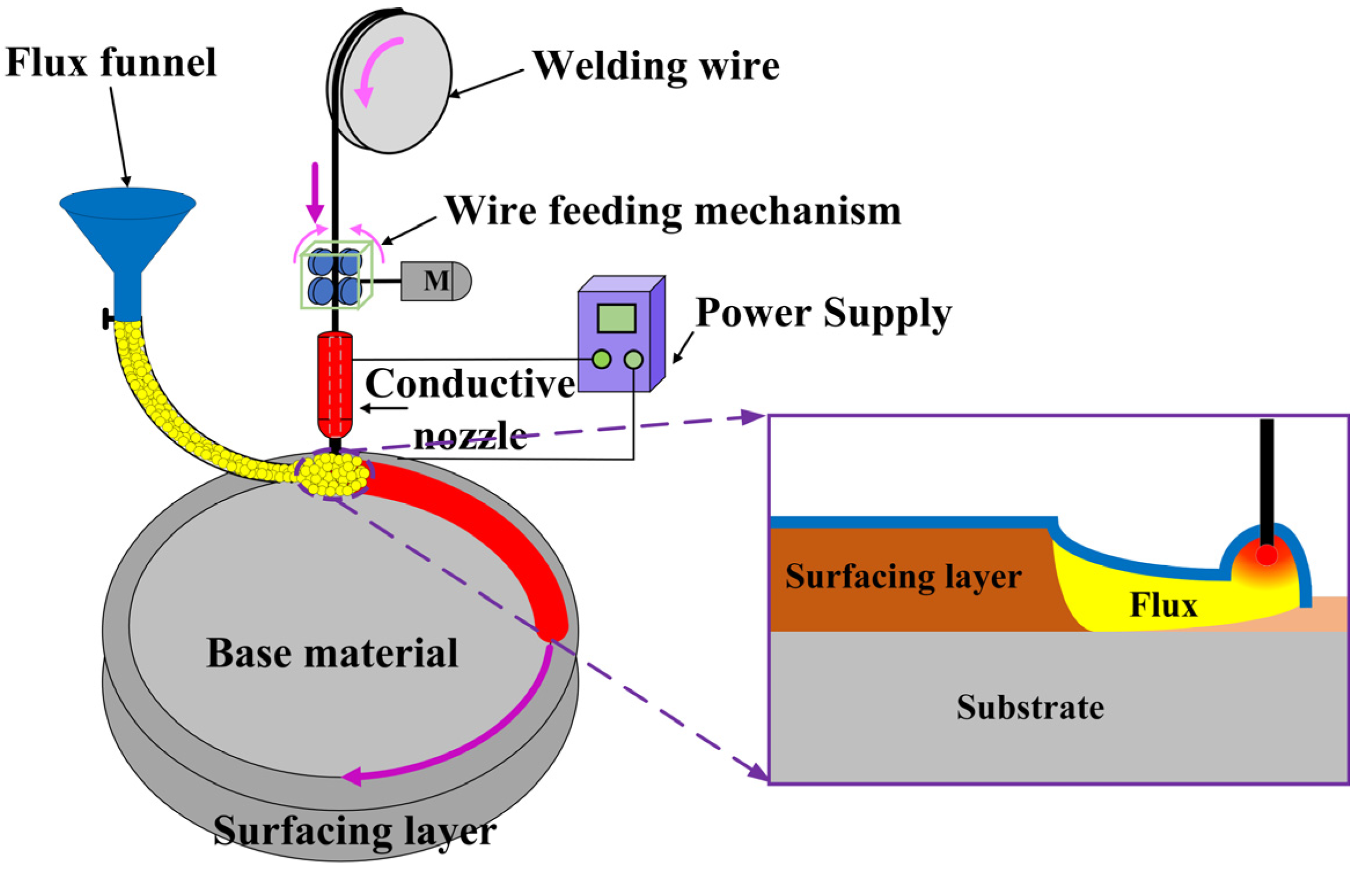
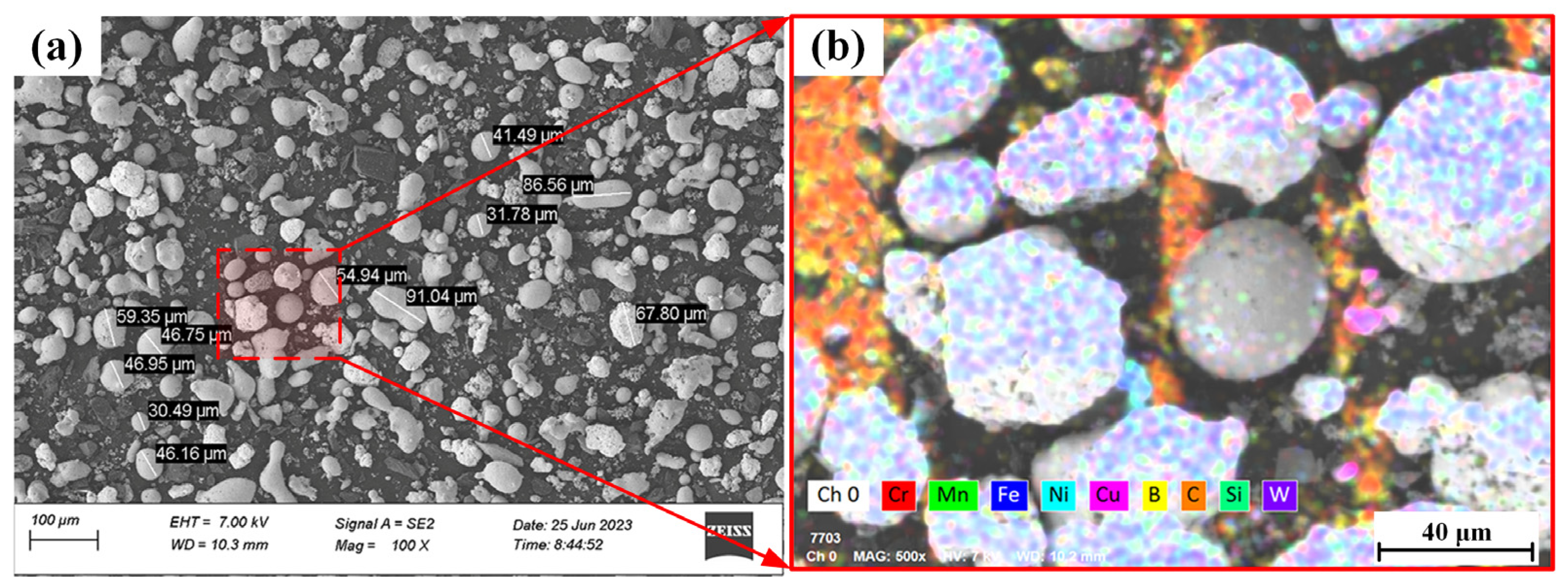
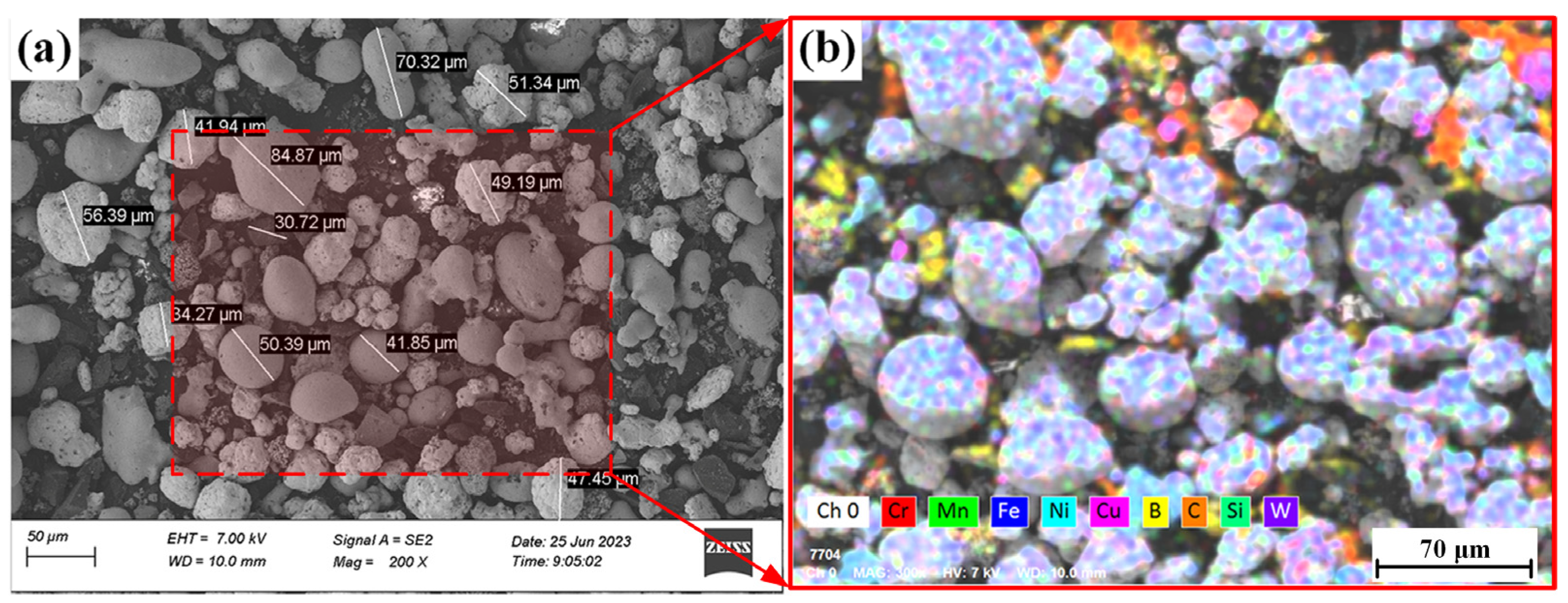
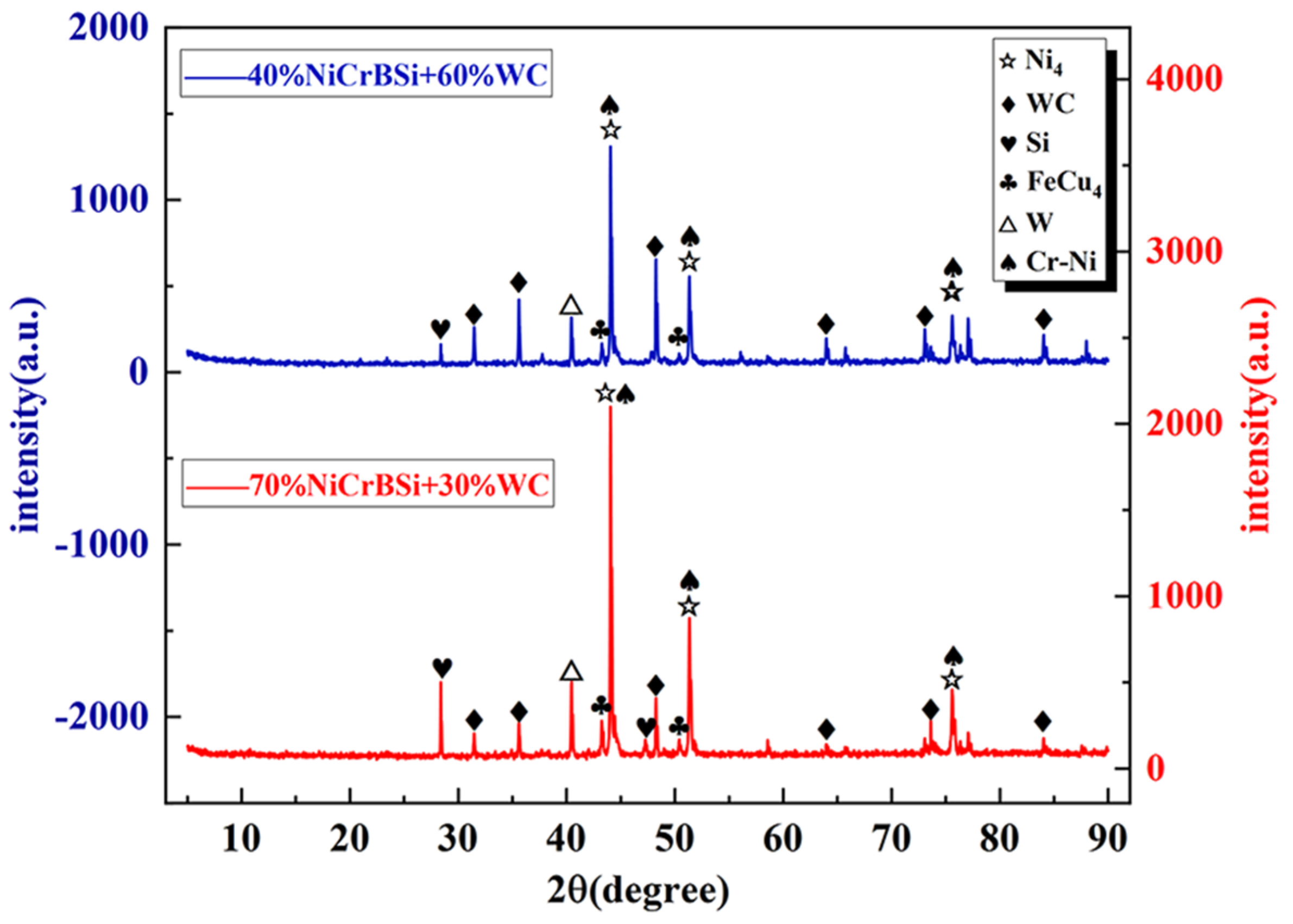

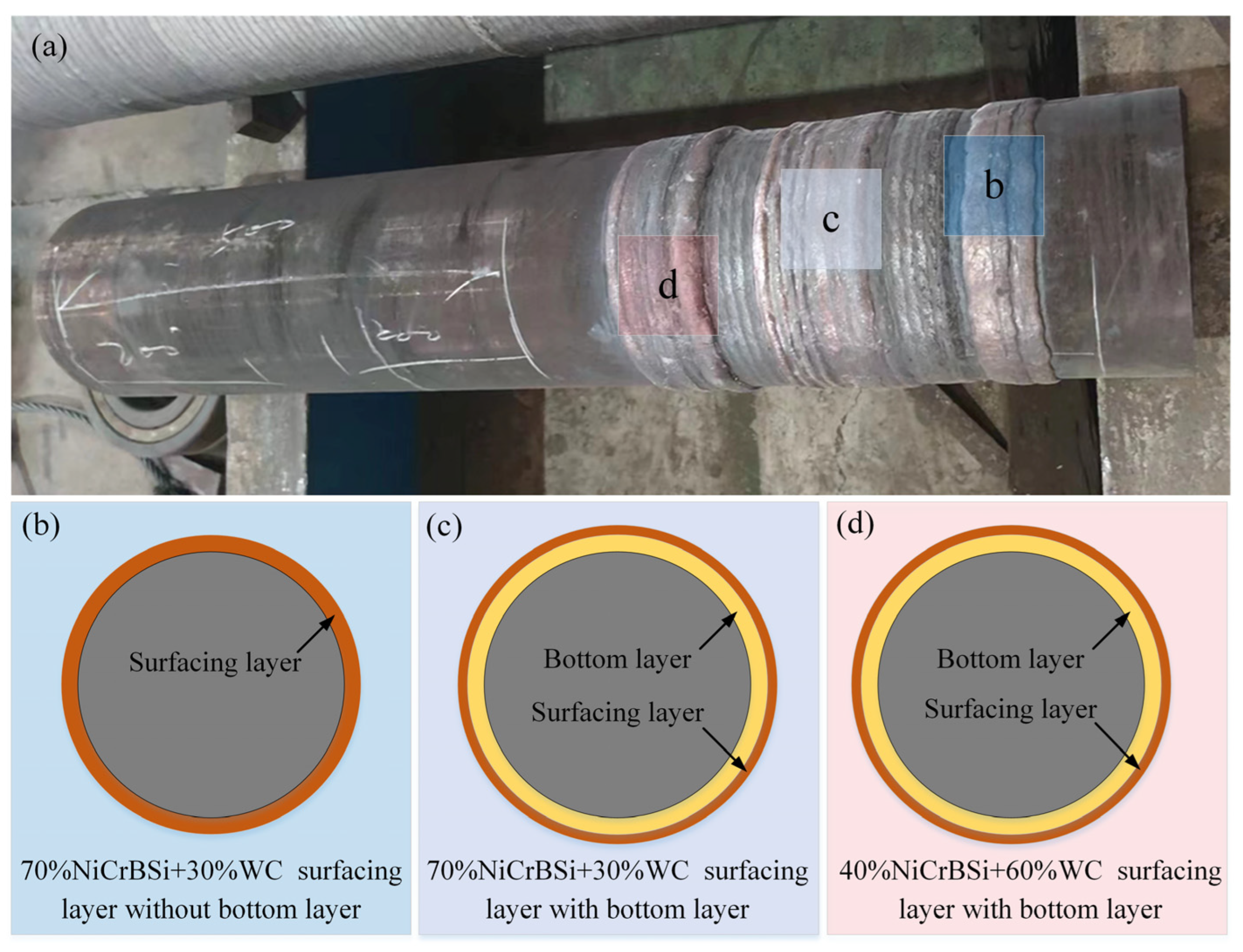
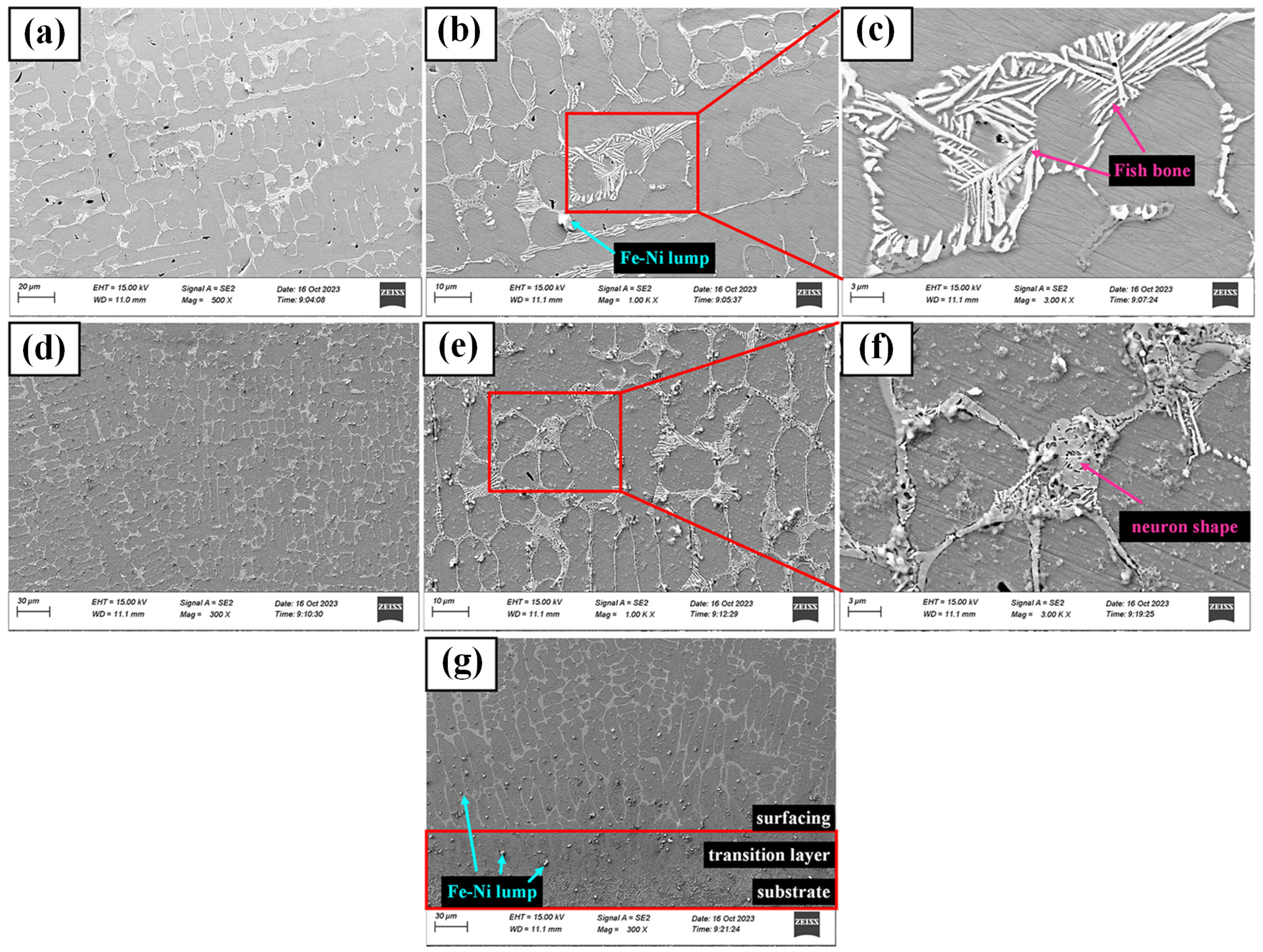
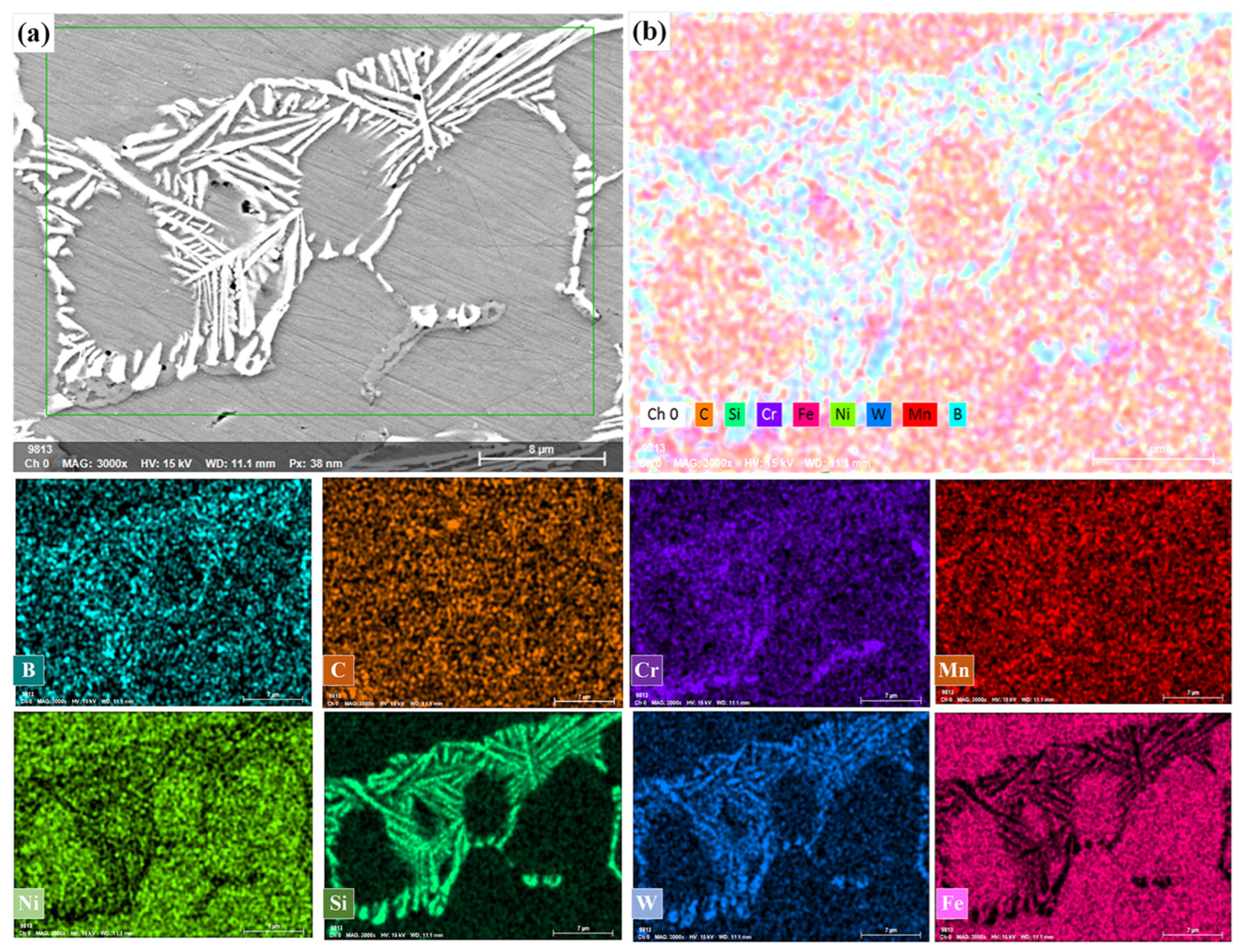
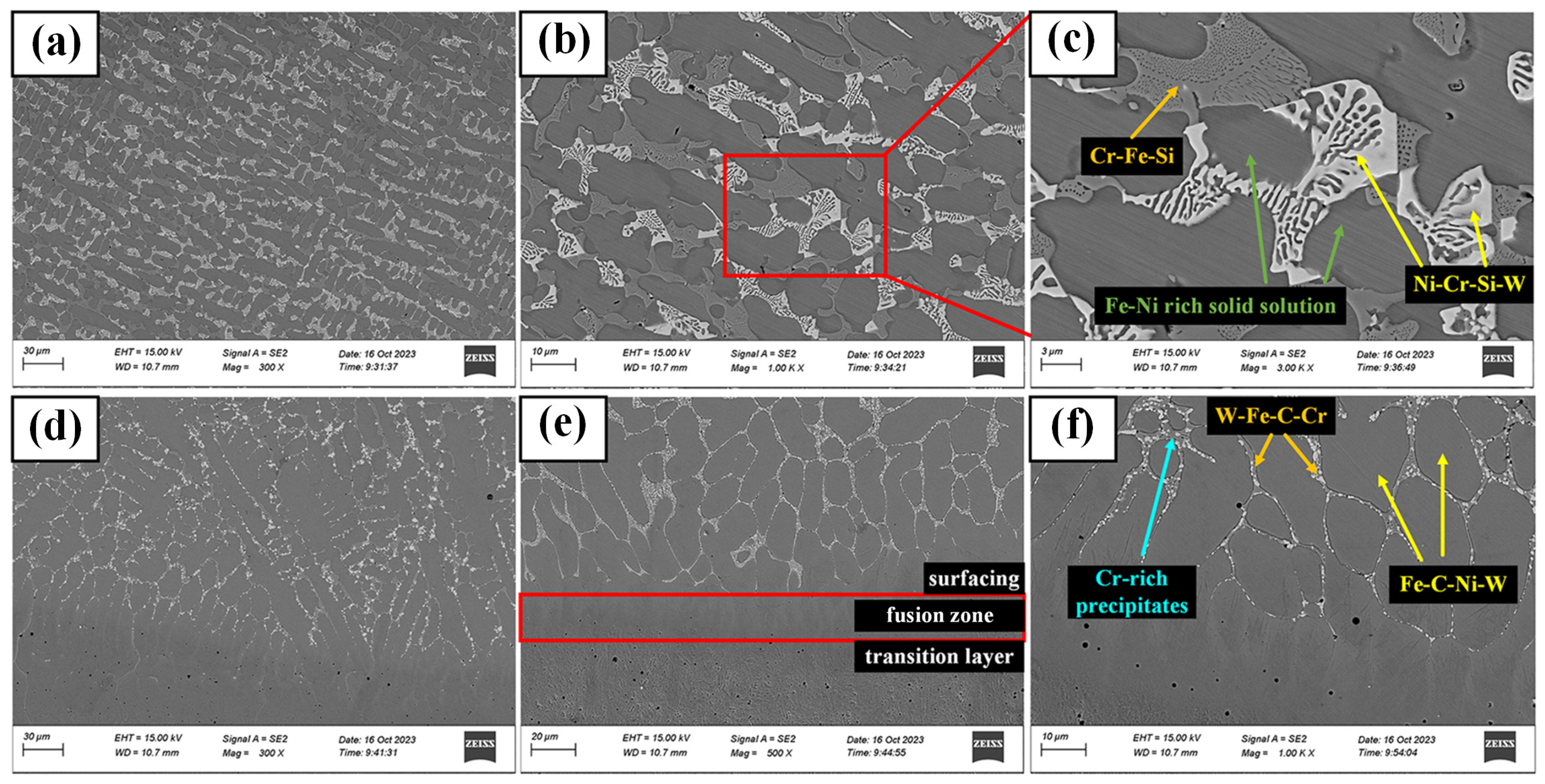
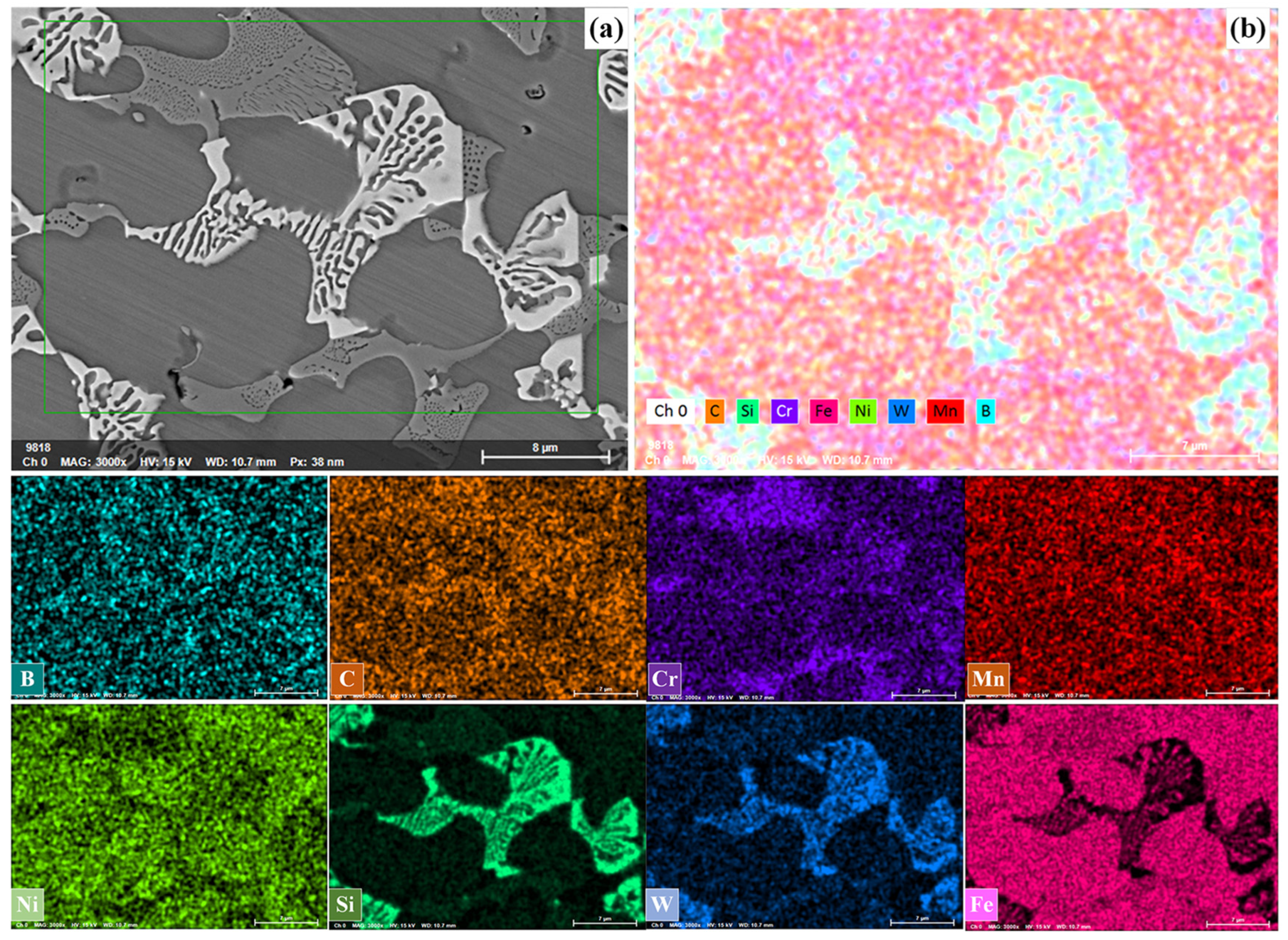
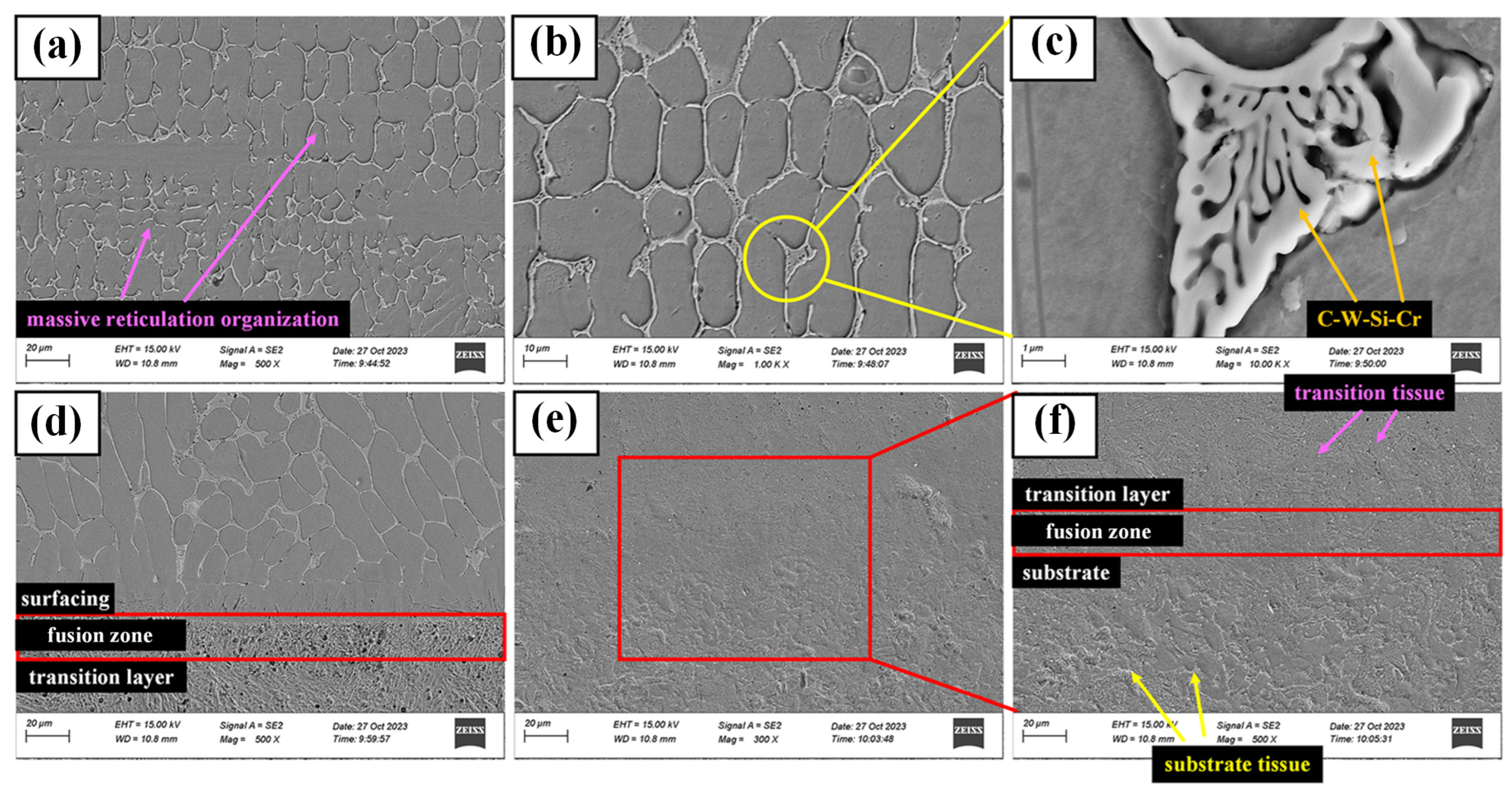
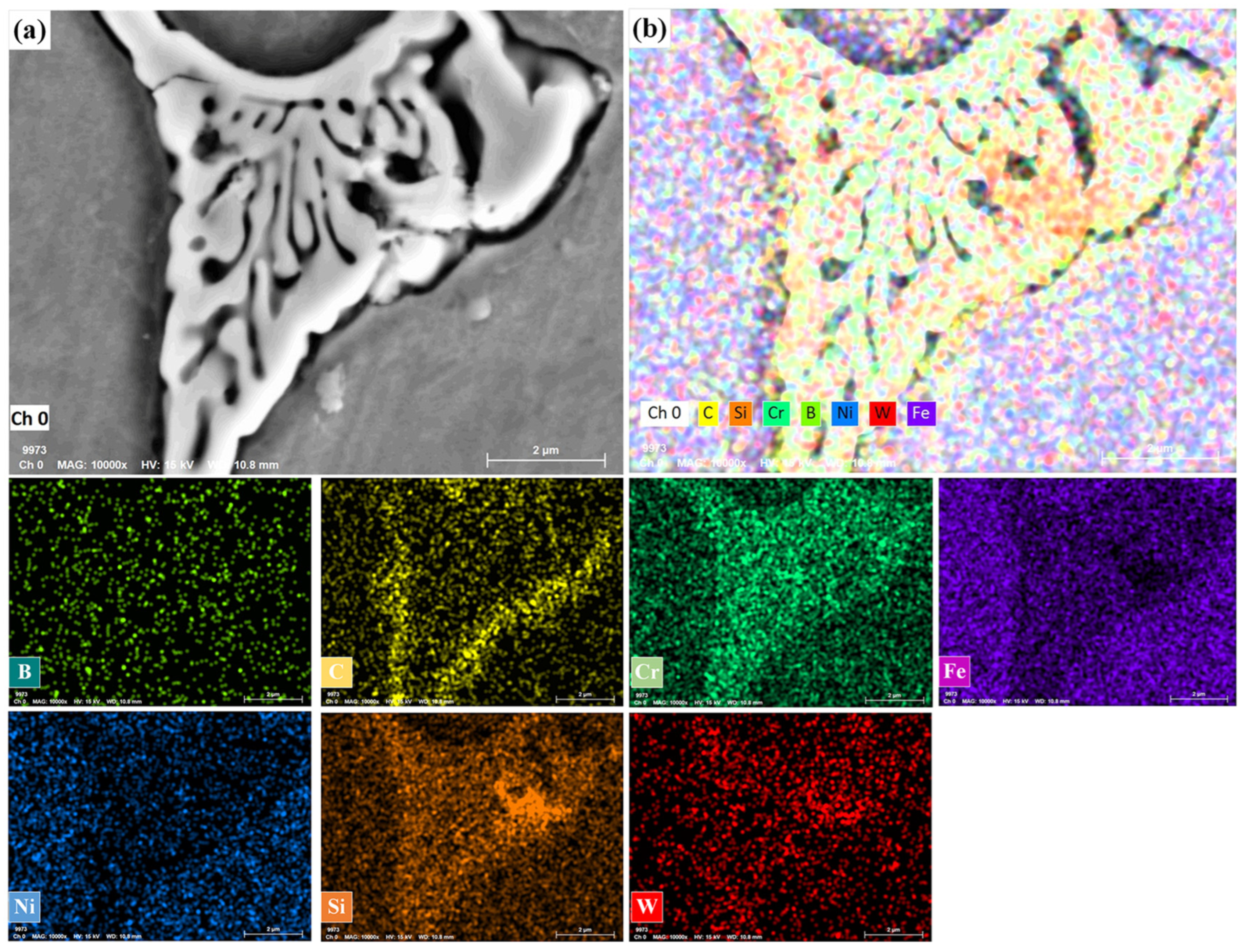
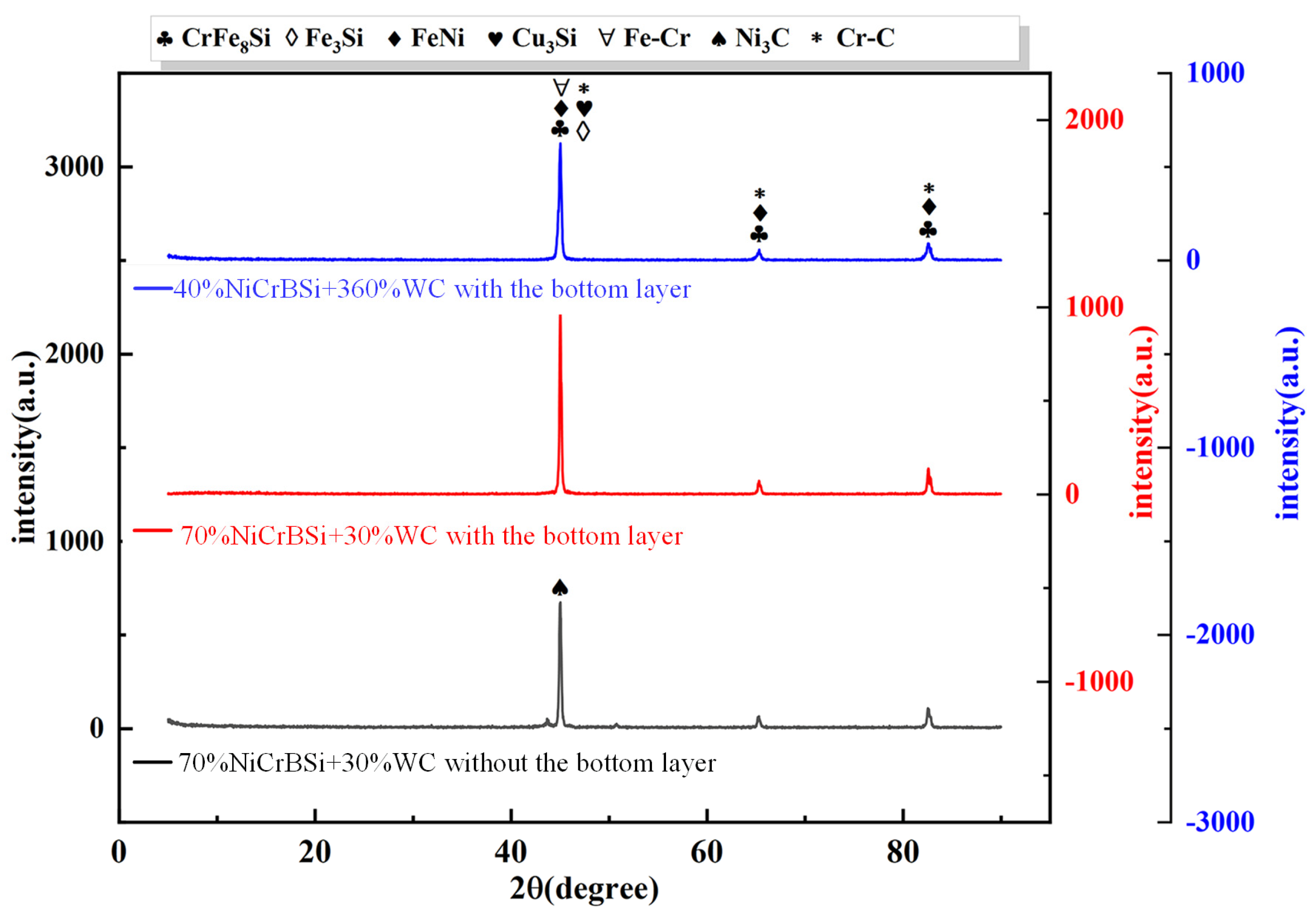




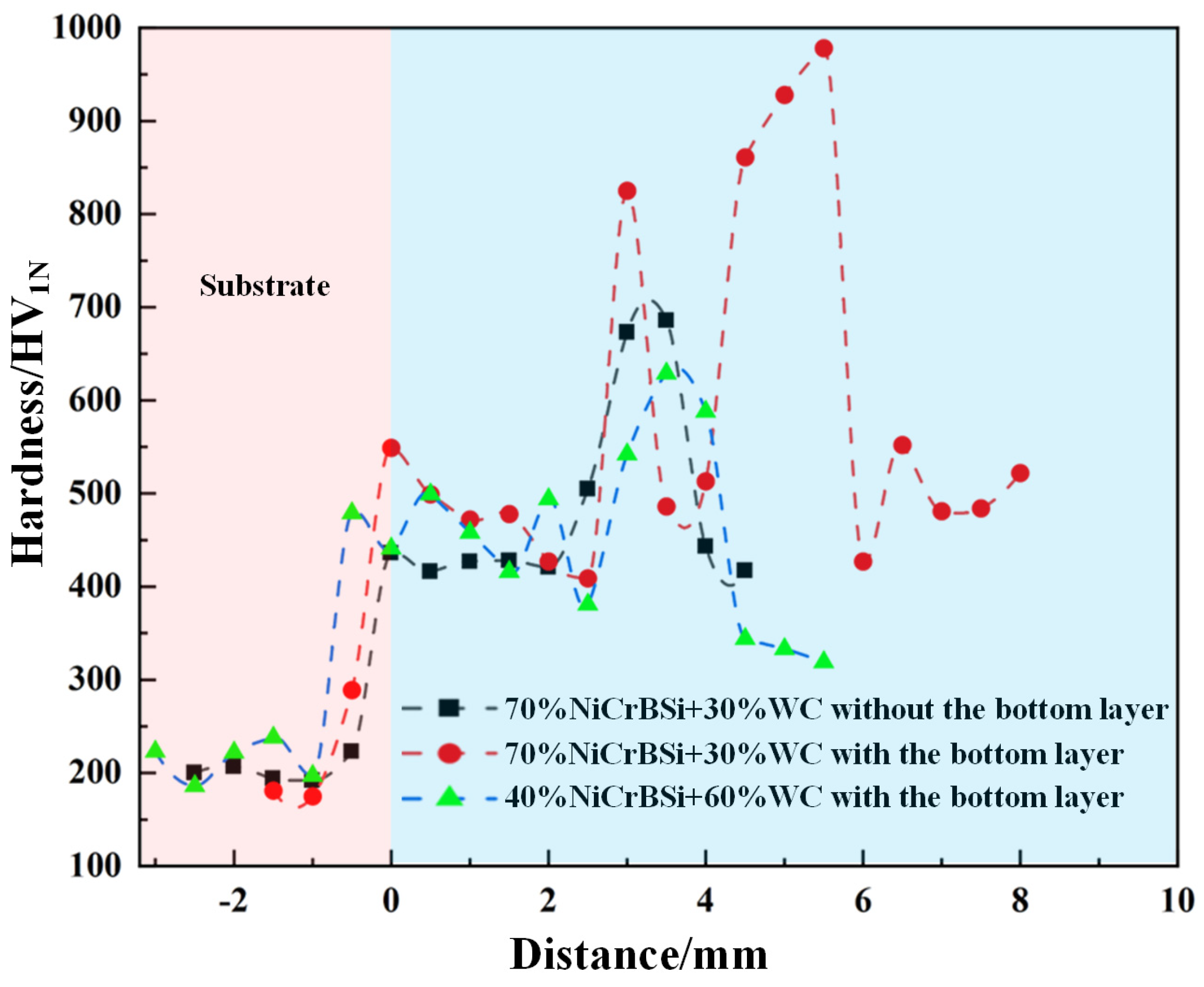
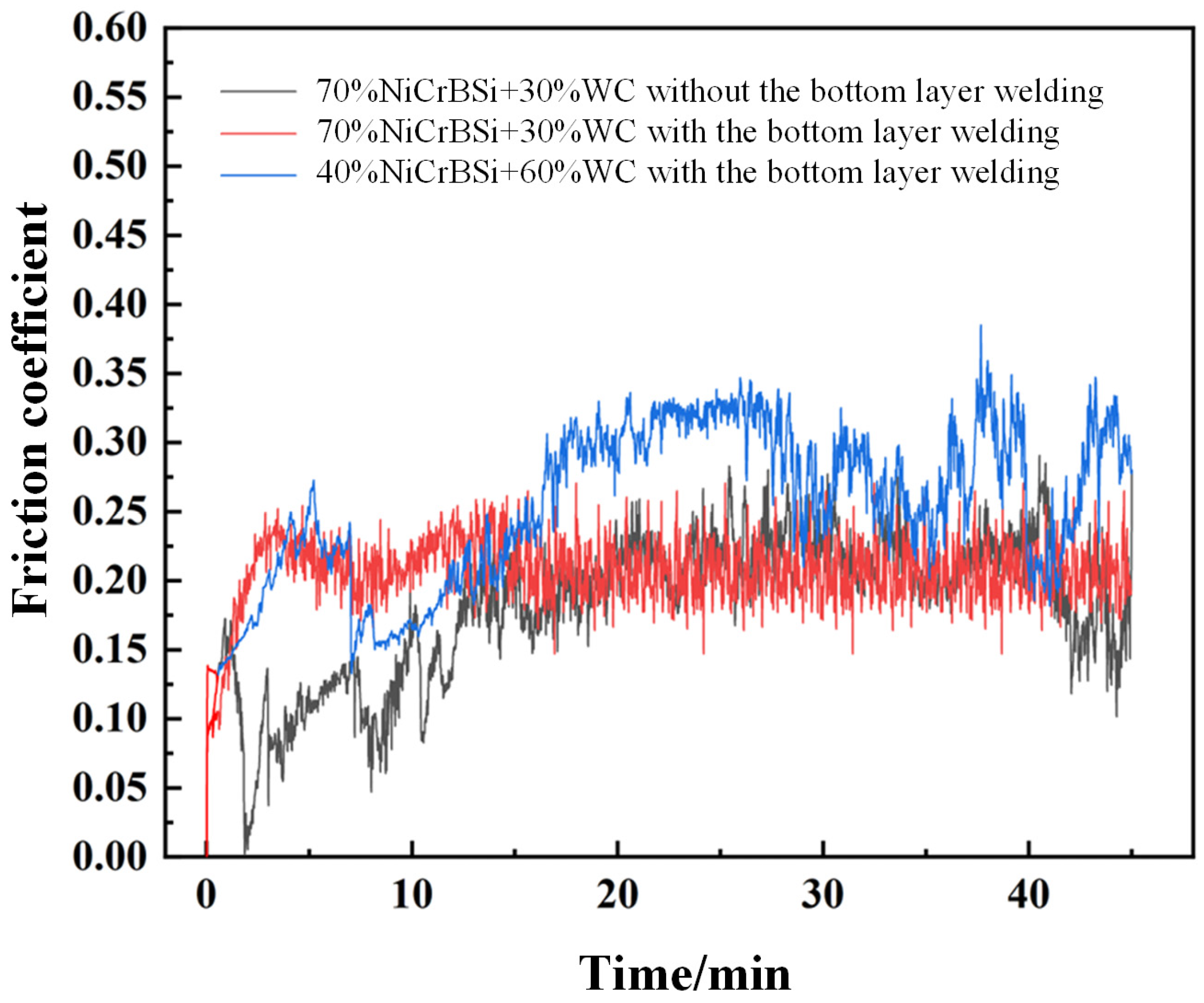
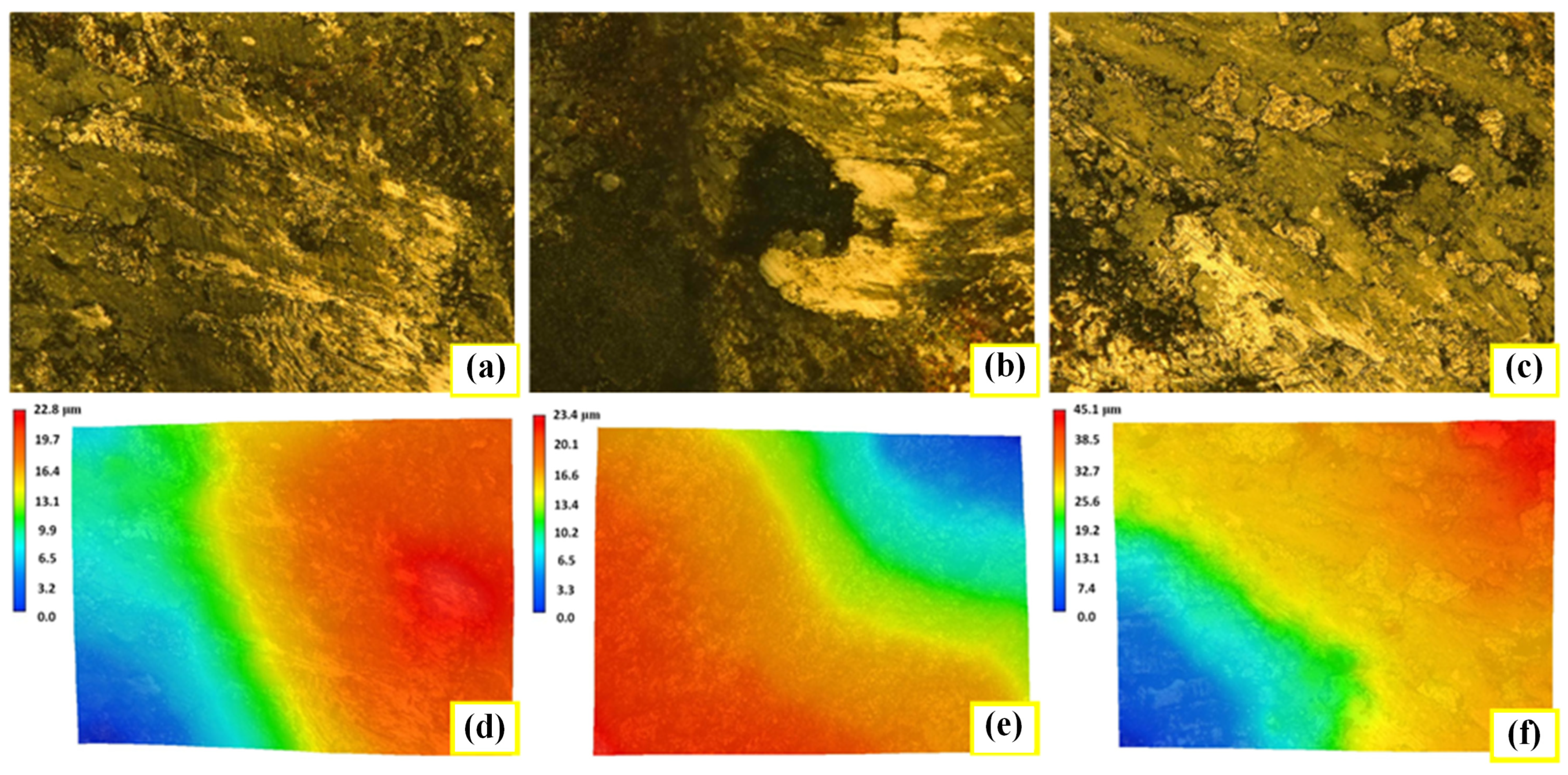
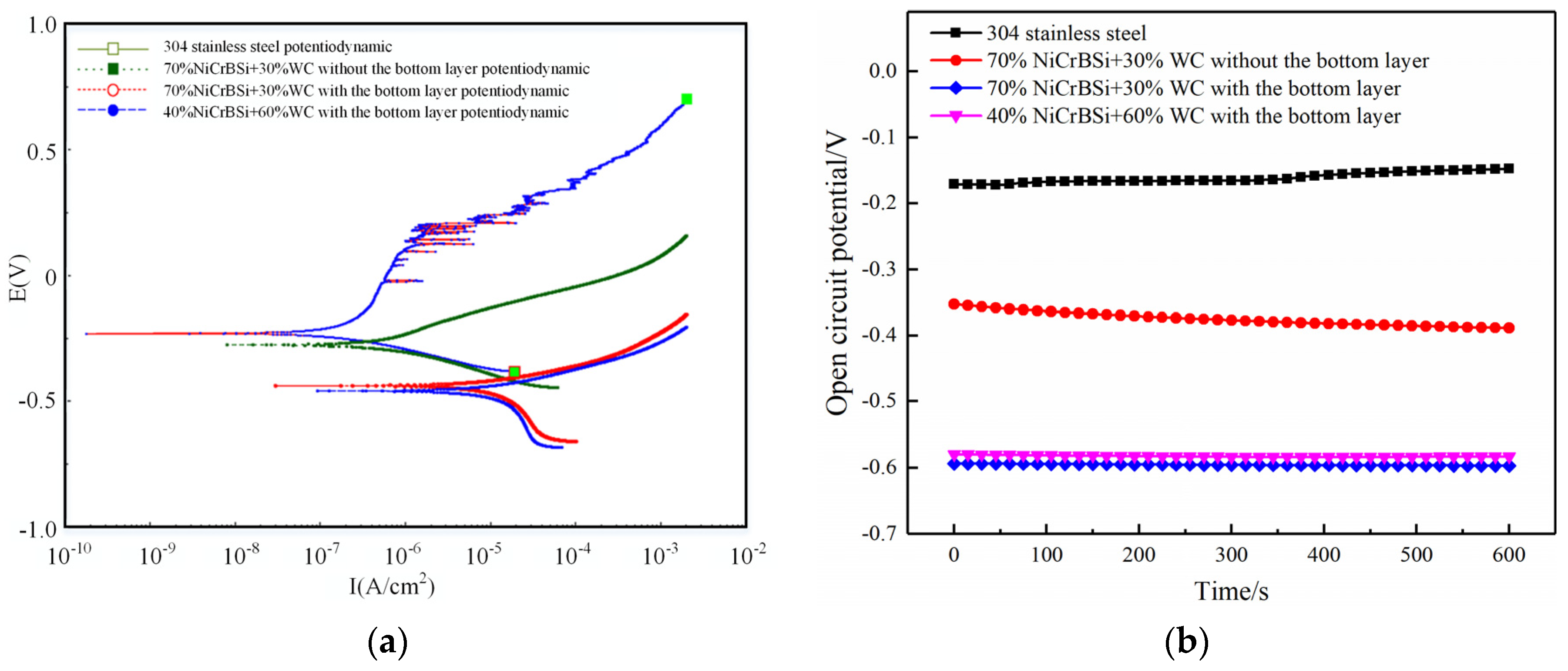
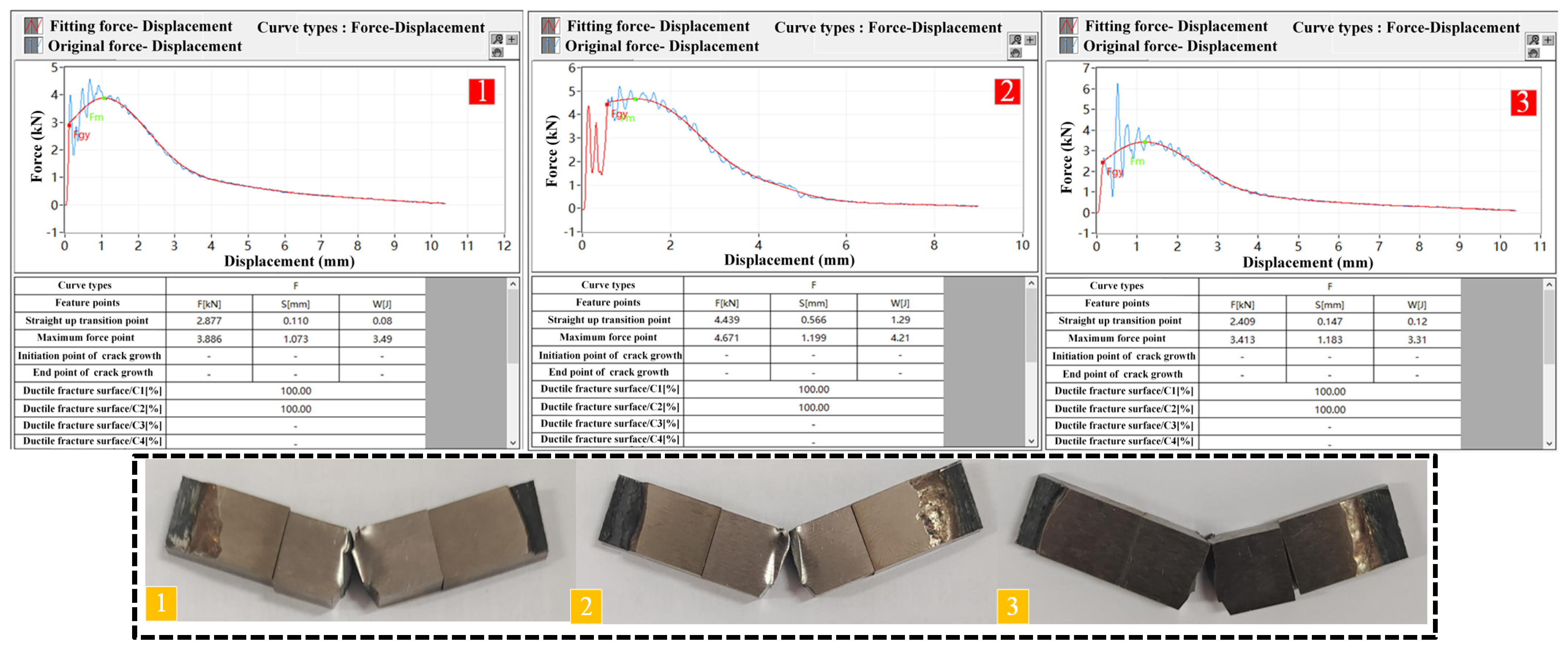
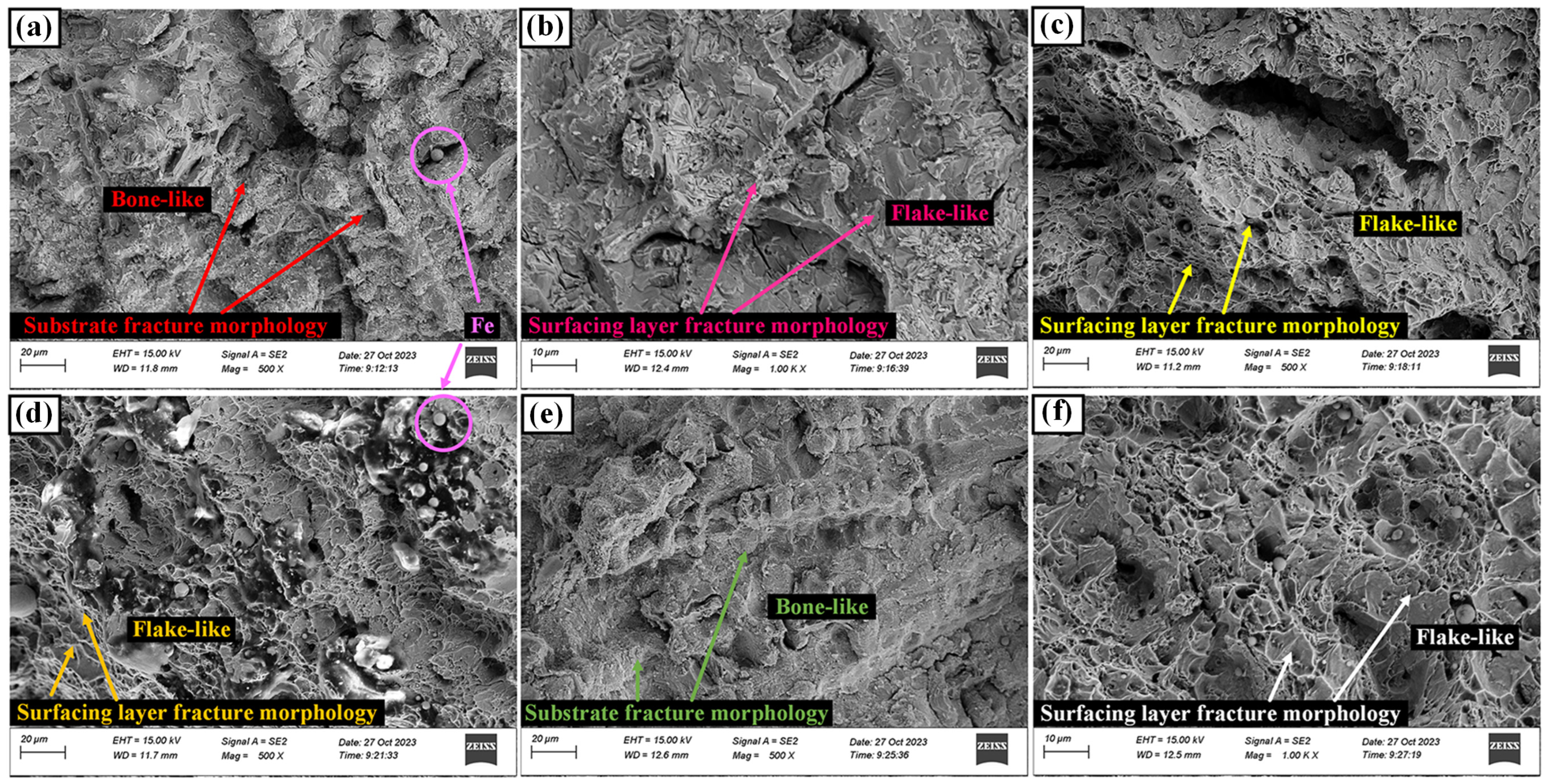
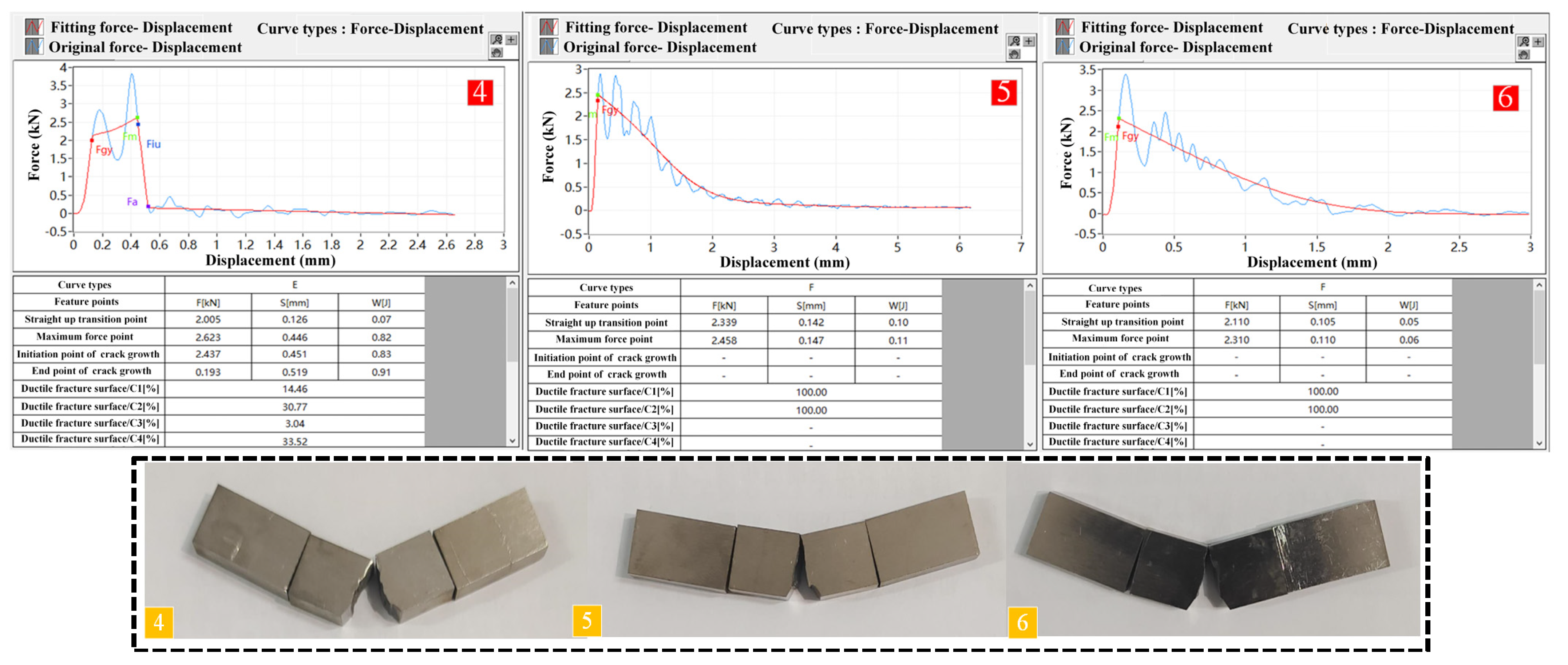
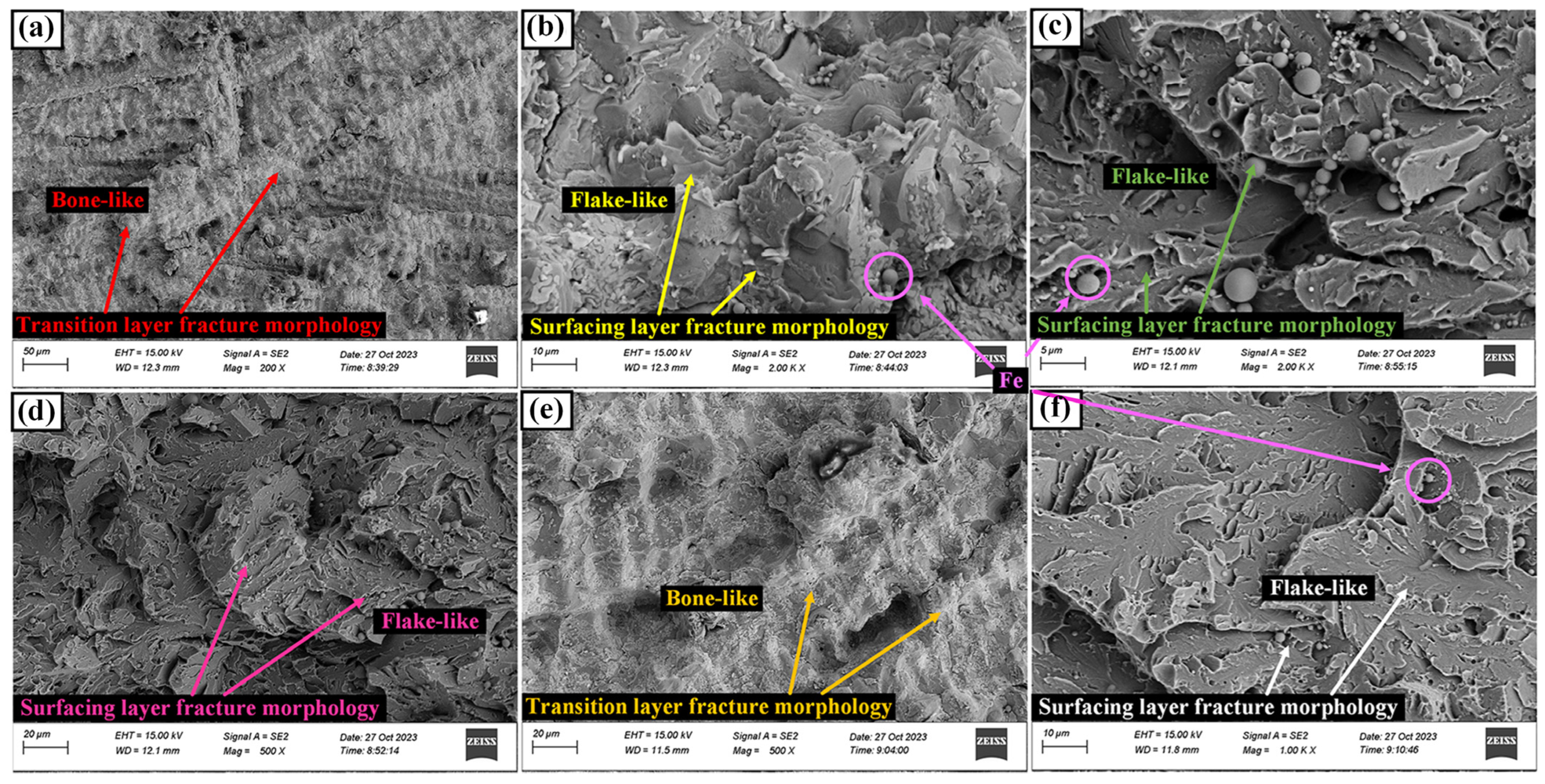
| Element | Ni | Mo | Cr | Mn | Si | C | P | S | Fe |
|---|---|---|---|---|---|---|---|---|---|
| Content (wt%) | 0.04 | 0.21 | 0.98 | 0.77 | 0.15 | 0.37 | 0.03 | 0.04 | Bal. |
| Element | C | Si | Mn | V | Mo | Cr | Ni | Fe |
|---|---|---|---|---|---|---|---|---|
| Content (wt%) | 0.25 | 0.5 | 1.5 | 0.25 | 1.5 | 3 | 2.5 | Bal. |
| Element | C | Mn | Si | P | S | Fe |
|---|---|---|---|---|---|---|
| Content (wt%) | 0.08 | 0.15 | 0.01 | 0.02 | 0.02 | Bal. |
| Element | C | Si | B | Cr | Fe | Ni |
|---|---|---|---|---|---|---|
| Content (wt%) | 0.3 | 3.3 | 1.7 | 8 | 2.3 | Bal. |
| Element | C | W |
|---|---|---|
| Content (wt%) | 6.0 | Bal. |
| Welding Parameter | Value |
|---|---|
| welding voltage/V | 38~40 |
| welding current/A | 410~420 |
| welding angular velocity/(rad/s) | 0.12~0.122 |
| welding speed/(mm/s) | 12~12.2 |
| feed rate of welding wire/(mm/s) | 14~16 |
| flux thickness/(mm) | 8~10 |
| electrode distance/(mm) | 30~32 |
| overlap rate | 30% |
| Number | Self-Corrosion Current Density I/(Amps/cm2) | Self-Corrosion Potential E/(Volts) | Corrosion Rate Corrosion Rate/(mm/a) |
|---|---|---|---|
| 304 stainless-steel | 1.79 × 10−10 | −0.23207 | 2.10 × 10−6 |
| 30% WC without the bottom layer | 5.57 × 10−8 | −0.27404 | 6.5389 × 10−4 |
| 30% WC with the bottom layer | 5.54 × 10−7 | −0.4383 | 6.4972 × 10−3 |
| 60% WC with the bottom layer | 6.02 × 10−8 | −0.47069 | 7.0596 × 10−4 |
| Sample Number | Setting | ||||||
|---|---|---|---|---|---|---|---|
| Temperature/°C | Sample Width/mm | Sample Thickness/mm | Absorbing Power/J | Impact Toughness/(J/cm2) | Total Impact Energy/J | Swing Angle/° | |
| without the bottom layer 1 | 25 | 10 | 5 | 13.76 | 34.40 | 12.76 | −150 |
| without the bottom layer 2 | 25 | 10 | 5 | 15.75 | 39.37 | 14.93 | −150 |
| without the bottom layer 3 | 25 | 10 | 5 | 14.38 | 35.95 | 11.90 | −150 |
| average | -- | -- | -- | 14.63 | 36.57 | 13.19 | -- |
| Sample Number | Setting | ||||||
|---|---|---|---|---|---|---|---|
| Temperature/°C | Sample Width/mm | Sample Thickness/mm | Absorbing Power/J | Impact Toughness/(J/cm2) | Total Impact Energy/J | Swing Angle/° | |
| with the bottom layer 4 | 25 | 10 | 5 | 1.28 | 3.20 | 0.00 | −150 |
| with the bottom layer 5 | 25 | 10 | 5 | 4.23 | 10.58 | 3.10 | −150 |
| with the bottom layer 6 | 25 | 10 | 5 | 2.47 | 6.17 | 0.00 | −150 |
| average | -- | -- | -- | 2.66 | 6.65 | 1.03 | -- |
Disclaimer/Publisher’s Note: The statements, opinions and data contained in all publications are solely those of the individual author(s) and contributor(s) and not of MDPI and/or the editor(s). MDPI and/or the editor(s) disclaim responsibility for any injury to people or property resulting from any ideas, methods, instructions or products referred to in the content. |
© 2024 by the authors. Licensee MDPI, Basel, Switzerland. This article is an open access article distributed under the terms and conditions of the Creative Commons Attribution (CC BY) license (https://creativecommons.org/licenses/by/4.0/).
Share and Cite
Li, C.; Feng, L.; Han, X.; Luo, F.; Sun, H. Experimental Study on the Process of Submerged Arc Welding for Nickel-Based WC Flux-Cored Wire on Descaling Roll. Coatings 2024, 14, 734. https://doi.org/10.3390/coatings14060734
Li C, Feng L, Han X, Luo F, Sun H. Experimental Study on the Process of Submerged Arc Welding for Nickel-Based WC Flux-Cored Wire on Descaling Roll. Coatings. 2024; 14(6):734. https://doi.org/10.3390/coatings14060734
Chicago/Turabian StyleLi, Chang, Lei Feng, Xing Han, Fenghua Luo, and Han Sun. 2024. "Experimental Study on the Process of Submerged Arc Welding for Nickel-Based WC Flux-Cored Wire on Descaling Roll" Coatings 14, no. 6: 734. https://doi.org/10.3390/coatings14060734
APA StyleLi, C., Feng, L., Han, X., Luo, F., & Sun, H. (2024). Experimental Study on the Process of Submerged Arc Welding for Nickel-Based WC Flux-Cored Wire on Descaling Roll. Coatings, 14(6), 734. https://doi.org/10.3390/coatings14060734







